Vision, Mission, Strategy
VISION
ULAP, representing member-leagues & federations of local government stakeholders, in partnership with the national government and strategic sectors, pursues full local autonomy and catalyzes nationbuilding towards inclusive and sustainable political, economic, and social development that will put the country at par with global standards.
MISSION
To unite, capacitate and strengthen all ULAP member-leagues & federations for a more effective and efficient delivery of basic services to local communities through transparent, accountable, innovative and participatory governance.
STRATEGY
Consistent with the national government’s Philippine Development Plan and the PPP Strategy, ULAP urges a strategic bottom-up approach in governance, for the national government to energize and support the local government sector to accomplish development goals in the local levels. It strongly believes that, to improve the delivery of services and to achieve “inclusive growth”, stronger national and local government coordination must be realized. In this strategy, ULAP envisions:
• To be a venue for transformative governance at the local level
• Serve as catalyst to localize national development
• To bridge various stakeholders to gather capacity and various resources
Convergence Framework
 ULAP is in the forefront for LGUs in discussing local issues with the national government, and bringing national policies, projects and programs on the ground. ULAP bridges the local government, with the help of all the member leagues, to the national government, private sector and civil society organizations. Over the years, ULAP’s responsibilities are becoming broader, and becoming more significant in local governance issues, problems and solutions.
ULAP is in the forefront for LGUs in discussing local issues with the national government, and bringing national policies, projects and programs on the ground. ULAP bridges the local government, with the help of all the member leagues, to the national government, private sector and civil society organizations. Over the years, ULAP’s responsibilities are becoming broader, and becoming more significant in local governance issues, problems and solutions.
Moreover, ULAP has been the connection of the LGUs to the opportunities being offered by the private sector, NGOs, CSOs and international development sector. Projects and programs of these sectors were brought to the LGUs, strategically looking at their local needs and matching them to the available projects and programs.
ULAP, since 2011, has been banking on its convergence framework in developing policies, projects and programs for the local government units from all the possible partners on international and national environment. As the umbrella organization of all local government leagues, ULAP has been fulfilling its mission to unite all member leagues, enhance their partnership with all stakeholders to attain genuine local autonomy for all LGUs, and ensure the smooth and efficient delivery of basic services to local communities for authentic and humane governance.
Local Governance Approach

In carrying out its role as a bridge of LGUs, ULAP has adopted a local governance approach for the various programs and policy advocacies it carries. This Local Governance Approach serves as a guide for analysis and resource-generation of ULAP to convene alliances and put together more holistic program and policy "packages" for LGUs. ULAP believes that in order for initiatives to be effective, they should be able to cover as many components as possible.
The Local Governance Approach has three components: Leadership, Supply and Demand.
LEADERSHIP
The Leadership component reflects the need for effective and efficient policy environments for Local governance, and well-capacitated local leaders to carry out mandates and innovate on complex development challenges. For this component, ULAP is guided by these board questions:
What policies in the national and local levels must be in place so that local leaders will be empowered to perform their work more effectively and efficiently?
What capacity-building inputs are needed so that local leaders can be strategic and effective in their work?
SUPPLY
The Supply component encapsulates the need for access and availability of a wide range of resources for local governments to drove the needed processes to be implemented. For this component, ULAP is guided by these board questions:
What local resources can be tapped and generated to enable policy and program implementation? How can these resources be effectively and efficiently spent for desired outcomes?
How can local governments engage national government agencies, private sector, and civil society partners to leverage on each other’s’ financial resources, technical capacities, human resources, and strategic networks?
DEMAND
Meanwhile, the Demand component reflects the need for community-level support and engagement for sustained and intensive collaborations with the people. For this component, ULAP is guided by these board questions:
How can initiatives foster demand-driven governance? What modes of direct engagement with local governments can be opened to local groups from various sectors?
How can involvement of local partners help local government sustain excellent initiatives?
How can excellent initiatives withstand political transitions and unpredictable resource-generation environments




